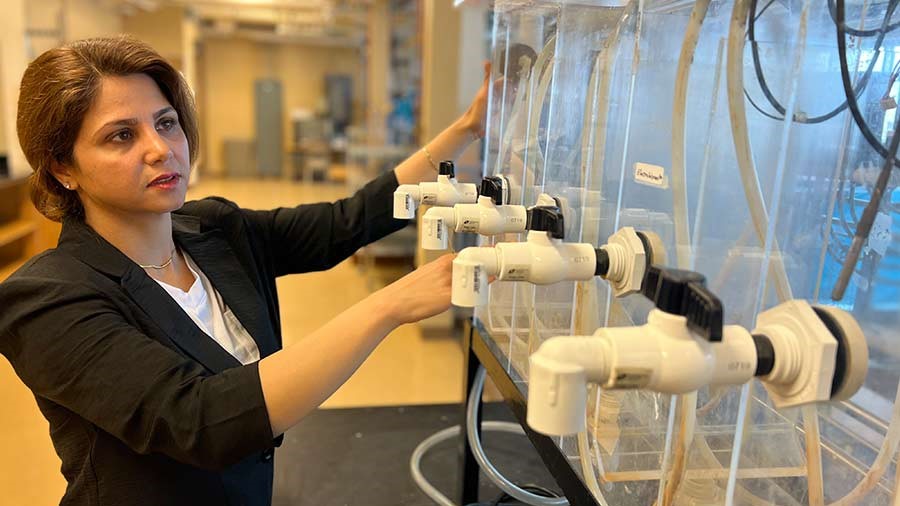South Dakota Mines Researcher Invents Revolutionary Onsite Wastewater Treatment Device

This piece by South Dakota Mines was published June 7.
Maryam Amouamouha, a graduate student at South Dakota Mines working on her second Ph.D., stands next to a prototype of AMBER, the system that she invented that could revolutionize wastewater treatment around the world.
Maryam Amouamouha, Ph.D., a graduate student at South Dakota Mines, has invented a new device that could revolutionize water treatment and improve water quality and availability around the world.
Amouamouha assembled a unique combination of current technologies and cutting-edge innovations to create a mini wastewater treatment plant called AMBER, for Anaerobic Membrane Bioreactor with Electrolytic Regeneration. The device can be installed in a home or business and take the place of a costly septic system. The invention can also be scaled up to clean wastewater from multiple homes or even a small town.
“Water is an issue everywhere; they have issues in India, Africa, the Middle East, and even here in the United States,” says Amouamouha. “Water shortages are likely to increase in the coming years, and, by recycling water with AMBER, we can save this precious resource for future generations.”
AMBER is a membrane bioreactor that employs a combination of electrochemical bioprocessing and nanocomposite filtration. Amouamouha has designed many of the components and received a provisional U.S. patent on the invention. The discharge from AMBER is clean water, as well as energy in the form of pure methane and compost. The discharged water is safe to drink, and it can be recycled in the home. The compost can be used for enhancing crop production, and the methane gas can be used as an energy source. “We’re capturing the methane in a propane tank that can be used for multiple applications, like heating a home,” says Amouamouha.
The system is more affordable than septic installation for a normal family home, and it can be set up in a basement, garage, or mechanical room. “You don’t need to put AMBER in the ground. It’s like an appliance (e.g., a generator) in your home that is hooked up to your plumbing system that will make clean water, energy, and compost all at the same time,” says Amouamouha.
Her passion for increasing the availability of clean water comes from her upbringing in the ancient farming town of Nahvand at the base of the Alvand Mountain Range in western Iran. “My grandfather farmed sunflower, corn, and beans. I was inspired to undertake this work after living in a country with water availability issues and after seeing people suffering from water shortages,” she says. “I want to do something that matters and that can make a change worldwide.”
Amouamouha finished her first Ph.D. in Iran at Shahid Beheshti University before seeking a second Ph.D. at South Dakota Mines. She came to Mines to work with Travis Walker, Ph.D., associate professor of chemical and biological engineering. She initially began working with Walker on research related to biofilm structure and control. “He has been an advisor and a champion of this work, and his support has been monumental in the success of AMBER,” says Amouamouha. She also credits Mel Ustad, Ph.D., project director for South Dakota EPSCoR, Joseph Wright, associate vice president for research — economic development at South Dakota Mines, and Jim Quinn and Rich Wells, both Entrepreneurs In Residence at South Dakota Mines, for their support and advocacy.
Amouamouha plans to build a business in South Dakota that manufactures AMBER for global distribution. Prototype testing is being completed with funding and support from Sioux Steel Company in Sioux Falls, SD, and an assembly and manufacturing facility will be set up in Rapid City, SD.
AMBER has won multiple awards, including the National Science Foundation’s Innovation Corps, and, most recently, first place in the highly competitive business category at the Governor’s Giant Vision Competition in Sioux Falls. “South Dakota is being so kind and supportive to me. I am confident we can move forward with mass manufacturing,” says Amouamouha. The next phase for AMBER is a public demonstration of the technology and regulatory approval before manufacturing can start later this year.
“Dr. Amouamouha’s work is a fantastic example of groundbreaking technology, created at Mines, that spins off into a local start-up,” says Mines President Jim Rankin, Ph.D. “Her research has major significance for water security around the planet, and the business she is building can be centered right here in South Dakota.”
 National Science Foundation RII Track-1 Project:Expanding Research, Education and Innovation in South Dakota
National Science Foundation RII Track-1 Project:Expanding Research, Education and Innovation in South Dakota